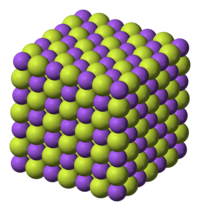Sodium fluoride
 |
|
| Names | |
|---|---|
| Pronunciation | /ˌsoʊdiəm ˈflʊəraɪd/ |
|
IUPAC name
Sodium fluoride
|
|
| Other names
Florocid
|
|
| Identifiers | |
|
7681-49-4 |
|
| ChEBI |
CHEBI:28741 |
| ChEMBL |
ChEMBL1528 |
| ChemSpider |
5045 |
| ECHA InfoCard | 100.028.789 |
| EC Number | 231-667-8 |
| KEGG |
C08142 |
| PubChem | 5235 |
| RTECS number | WB0350000 |
| UNII |
8ZYQ1474W7 |
| UN number | 1690 |
|
|
| Properties | |
| NaF | |
| Molar mass | 41.988173 g/mol |
| Appearance | White to greenish solid |
| Odor | odorless |
| Density | 2.558 g/cm3 |
| Melting point | 993 °C (1,819 °F; 1,266 K) |
| Boiling point | 1,704 °C (3,099 °F; 1,977 K) |
| 36.4 g/L (0 °C); 40.4 g/L (20 °C); 50.5 g/L (100 °C) |
|
| Solubility | slightly soluble in HF, ammonia negligible in alcohol, acetone, SO2, dimethylformamide |
| Vapor pressure | 1 mmHg @ 1077 C° |
| −16.4·10−6 cm3/mol | |
|
Refractive index (nD)
|
1.3252 |
| Structure | |
| Cubic | |
|
a = 462 pm
|
|
| Octahedral | |
| Thermochemistry | |
| 46.82 J/mol K | |
|
Std molar
entropy (S |
51.3 J/mol K |
|
Std enthalpy of
formation (ΔfH |
-573.6 kJ/mol |
|
Gibbs free energy (ΔfG˚)
|
-543.3 kJ/mol |
| Pharmacology | |
|
A01AA01 (WHO) A12CD01 (WHO), V09IX06 (WHO) (18F) |
|
| Hazards | |
| Safety data sheet | |
| H301, H315, H319 | |
|
EU classification (DSD)
|
|
| R-phrases | R25, R32, R36/38 |
| S-phrases | (S1/2), S22, S36, S45 |
| NFPA 704 | |
| Flash point | Non-flammable |
| Lethal dose or concentration (LD, LC): | |
|
LD50 (median dose)
|
52–200 mg/kg (oral in rats, mice, rabbits) |
| US health exposure limits (NIOSH): | |
|
PEL (Permissible)
|
TWA 2.5 mg/m3 |
|
REL (Recommended)
|
TWA 2.5 mg/m3 |
|
IDLH (Immediate danger)
|
250 mg/m3 (as F) |
| Related compounds | |
|
Other anions
|
Sodium chloride Sodium bromide Sodium iodide Sodium astatide |
|
Other cations
|
Lithium fluoride Potassium fluoride Rubidium fluoride Caesium fluoride Francium fluoride |
|
Related compounds
|
TASF reagent |
|
Except where otherwise noted, data are given for materials in their standard state (at 25 °C [77 °F], 100 kPa).
|
|
|
|
|
| Infobox references | |
Sodium fluoride (NaF) is a chemical compound and medication. As a medication it is primarily used to prevent tooth decay in children older than 6 months in areas where the drinking water is low in fluoride. Sodium fluoride is used as a liquid, pill, or paste by mouth with this use being known as fluoride therapy.
Normal doses may occasionally result in white marks on the teeth. Excessive doses can result in brown or yellow coloring of the teeth. It is believed to work mostly through direct contact with the teeth. Sodium fluoride is a colorless solid. It is most often made by mixing fluorosilicic acid with sodium hydroxide.
Sodium fluoride came into use to prevent tooth decay in the 1940s. It is on the World Health Organization's List of Essential Medicines, the most important medications needed in a basic health system. In the United Kingdom a typical month supply costs the NHS about 0.36 pounds. It is also commonly used for water fluoridation and added to toothpaste.
Fluoride salts are often added to municipal drinking water (as well as certain food products in some countries) for the purposes of maintaining dental health. The fluoride enhances the strength of teeth by the formation of fluorapatite, a naturally occurring component of tooth enamel. Although sodium fluoride is used to fluoridate water and, indeed, is the standard by which other water-fluoridation compounds are gauged, hexafluorosilicic acid (H2SiF6) and its salt sodium hexafluorosilicate (Na2SiF6) are more commonly used additives in the U.S.Toothpaste often contains sodium fluoride to prevent cavities, although tin(II) fluoride is generally considered superior for this application.
...
Wikipedia

